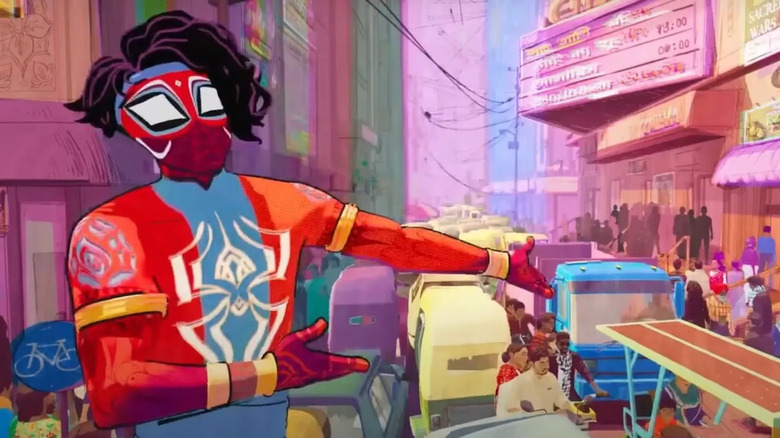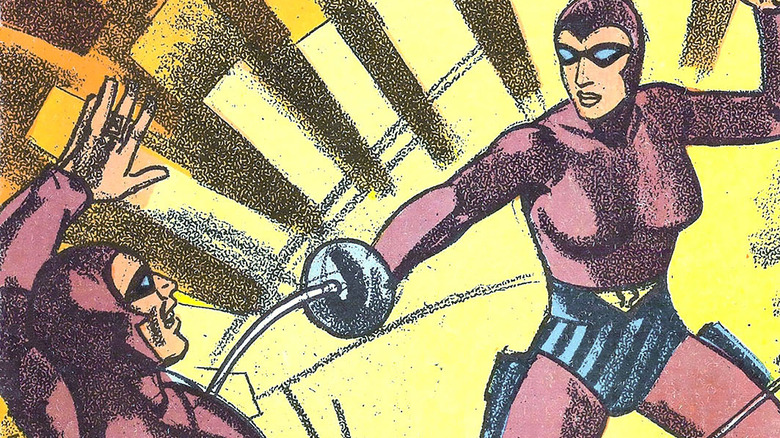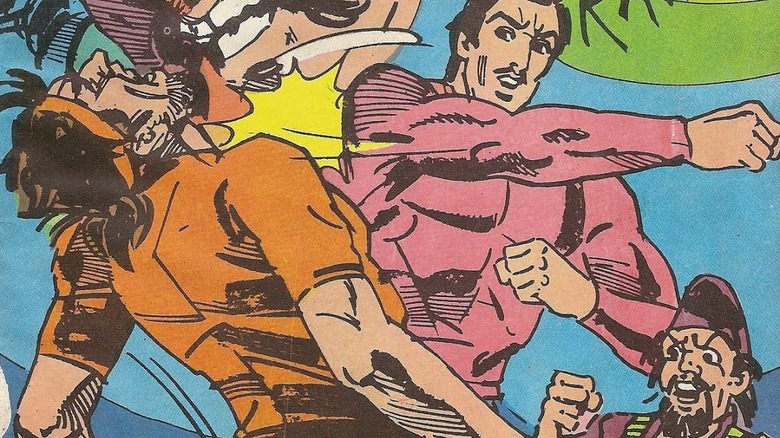Across The Spider-Verse's Indian Spider-Man Drew Inspiration From 1970s Indian Indrajal Comics & More
There are an overwhelming number of Spider-People on display in the new animated film "Spider-Man: Across the Spider-Verse," so stopping to analyze each one has been a massive task. Some of the characters have long and storied histories in Marvel Comics, such as Miguel O'Hara (Oscar Isaac), aka Spider-Man 2099. Others are mere winks to one-shot characters that only barely appeared on the page, such as Peter Parkedcar, a Spider-Man that is also a dune buggy.
One of the more notable Spiders in "Across the Spider-Verse" was Pavitr Prabhakar (Karan Soni), aka. Spider-Man India, a character who lives in the high-tech city of Mumbattan (an amalgam of Mumbai and Manhattan). When the film's main character, Miles Morales (Shameik Moore) skipped merrily into a parallel universe, he and Pavitr briefly teamed up to stop an interdimensional villain. Miles would also learn that Pavitr, unlike most Spider-Men, had not yet suffered an origin-story-level personal tragedy; he was still early in his career.
Pavitr was inspired by the "Spider-Man: India" comics, first published in 2004. It seems that the legendary filmmaker Satyajit Ray once convinced Marvel svengali Stan Lee to create the character. Sadly, Pavitr wouldn't be created until years after Ray's death. "Spider-Man: India" was only a four-issue miniseries, but thanks to the long memory of Marvel Comics, instantly became a permanent part of Spider-Man lore. In 2023, Pavitr was finally seen on the big screen.
According to the new book "Spider-Man: Across the Spider-Verse: The Art of the Movie," the designs for Pavitr were inspired by deep-cut Indian comics that anyone outside of India likely hasn't heard of. The film's designers looked into Indrajal Comics, a local imprint best known for regional stories about the Phantom, Flash Gordon, and Mandrake the Magician.
Indrajal Comics
Indrajal Comics was launched in 1964, and their initial bread and butter were original stories about characters ordinarily found in King Features comics. The Phantom — that is, the one in the purple body stocking — was the company's first big hit, followed by Flash Gordon, et al. The comics were published in multiple languages across the entire country.
It wouldn't be until 1976 that Indrajal would invent its own, original superhero in the form of Bahadur, created by Aabid Surti. Bahadur was a child whose father was murdered during a bout of street violence. Real-life street violence was running high in India in 1976, so the character was topical. Bahadur initially wanted to kill his father's murderer but eventually teamed up with the local police to fight crime, freelance, as part of the Citizen's Security Force. Bahadur wielded guns, had a barrel chest, and wore a tight pink sweater. He was a sexy badass.
Indrajal comics continued until 1990 when its parent company pulled the plug. Those who grew up in India in the 1970s through the 1990s likely remember reading Bahadur comics or were at least familiar with Indrajal.
"Across the Spider-Verse" producer and co-writer Phil Lord pointed out that his film's designers were indeed familiar with Indrajal, and that the comics' old designs and colors — and even paper stock — played a huge part when it came to realizing Pavitr. He said:
"Several artists really dominated those comics, and they are famous for their loose line work. [...] There is a specific way these comics were printed, which we recreated for Pavitr's section of the movie. We wanted to really feel the tooth and texture of the paper that it was printed on."
The glories of old comics
"Across the Spider-Verse" co-director Joaquim Dos Santos pointed out that a lot of the film's artists were raised in India and recall the Indrajal titles with nostalgia. Using that aesthetic, the filmmakers then employed the latest in animation technology to blend New York City with Mumbai, creating a high-tech utopia straight from the pages of a 1970s pulp rag. Do Santos said:
"For some of the film's crew members who grew up in India, these were the formative comic books that they grew up with; those comics have so much visual texture, which we studied, broke down, and utilized to shape our ideas for what this world could look and feel like. We essentially hybridized Mumbai and Manhattan and emptied out the East River — so the East River is this giant chasm where the city is sort of built and stacked down, levels upon levels. The way the Spiders move through that world is simply stunning."
The design of Pavitr himself, however, was not Indrajal-inspired, nor was he lifted from the "Spider-Man: India" comics. The movie version of Pavitr was put together by artist Naveen Selvanathan, who interpolated the classic 1964 Spider-Man costume through the aesthetics of "Theyyam and Yak-shagana dancers, temple architecture, henna patterns, and contemporary Indian fashions."
The result is a Spider-Man that looks both classic and new while being definitively Indian. Sadly, the filmmakers didn't decide to go with Bahadur's signature pink shirt. Perhaps, if the filmmakers are feeling ambitious, Bahadur can appear in the next Spider-Verse movie, currently in production. In fact, let's start an untrue rumor right now:
BREAKING: Bahadur to appear extensively in "Spider-Man: Beyond the Spider-Verse." All other Spider-People die out. Bahadur will remain the only hero.


